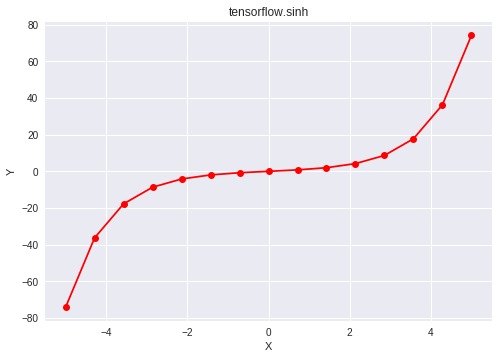Tensorflow是Google开发的开源机器学习库。它的应用之一是开发深度神经网络。
模块tensorflow.math为许多基本的数学运算提供支持。函数tf.sinh()[别名tf.math.sinh]支持Tensorflow中的双曲正弦函数。它期望以弧度形式输入。输入类型为张量,如果输入包含多个元素,则将计算按元素的双曲正弦值。
用法:tf.sinh(x, name=None) or tf.math.sinh(x, name=None)
参数:
x:以下任何类型的张量:float16,float32,float64,complex64或complex128。
name(可选):操作的名称。
返回类型:与x具有相同类型的张量。
代码1:
# Importing the Tensorflow library
import tensorflow as tf
# A constant vector of size 6
a = tf.constant([1.0, -0.5, 3.4, -2.1, 0.0, -6.5],
dtype = tf.float32)
# Applying the sinh function and
# storing the result in 'b'
b = tf.sinh(a, name ='sinh')
# Initiating a Tensorflow session
with tf.Session() as sess:
print('Input type:', a)
print('Input:', sess.run(a))
print('Return type:', b)
print('Output:', sess.run(b))输出:
Input type:Tensor("Const_3:0", shape=(6, ), dtype=float32)
Input:[ 1. -0.5 3.4 -2.1 0. -6.5]
Return type:Tensor("sinh:0", shape=(6, ), dtype=float32)
Output:[ 1.1752012 -0.5210953 14.965365 -4.0218563 0.
-332.57004 ]
代码2:可视化
# Importing the Tensorflow library
import tensorflow as tf
# Importing the NumPy library
import numpy as np
# Importing the matplotlib.pylot function
import matplotlib.pyplot as plt
# A vector of size 15 with values from -5 to 5
a = np.linspace(-5, 5, 15)
# Applying the hyperbolic sine function and
# storing the result in 'b'
b = tf.sinh(a, name ='sinh')
# Initiating a Tensorflow session
with tf.Session() as sess:
print('Input:', a)
print('Output:', sess.run(b))
plt.plot(a, sess.run(b), color = 'red', marker = "o")
plt.title("tensorflow.sinh")
plt.xlabel("X")
plt.ylabel("Y")
plt.show()输出:
Input:[-5. -4.28571429 -3.57142857 -2.85714286 -2.14285714 -1.42857143 -0.71428571 0. 0.71428571 1.42857143 2.14285714 2.85714286 3.57142857 4.28571429 5. ] Output:[-74.20321058 -36.32033021 -17.76962587 -8.67713772 -4.20321865 -1.96654142 -0.77659271 0. 0.77659271 1.96654142 4.20321865 8.67713772 17.76962587 36.32033021 74.20321058]

相关用法
- Python PyTorch sinh()用法及代码示例
- Python Tensorflow cos()用法及代码示例
- Python Tensorflow log()用法及代码示例
- Python Tensorflow abs()用法及代码示例
- Python Tensorflow tan()用法及代码示例
- Python Tensorflow sin()用法及代码示例
- Python Tensorflow exp()用法及代码示例
- Python Tensorflow atanh()用法及代码示例
- Python Tensorflow logical_not()用法及代码示例
- Python Tensorflow acosh()用法及代码示例
- Python Tensorflow acos()用法及代码示例
- Python Tensorflow asin()用法及代码示例
- Python Tensorflow reciprocal()用法及代码示例
- Python Tensorflow asinh()用法及代码示例
- Python Tensorflow atan()用法及代码示例
注:本文由纯净天空筛选整理自vaibhav29498大神的英文原创作品 Python | Tensorflow sinh() method。非经特殊声明,原始代码版权归原作者所有,本译文未经允许或授权,请勿转载或复制。
